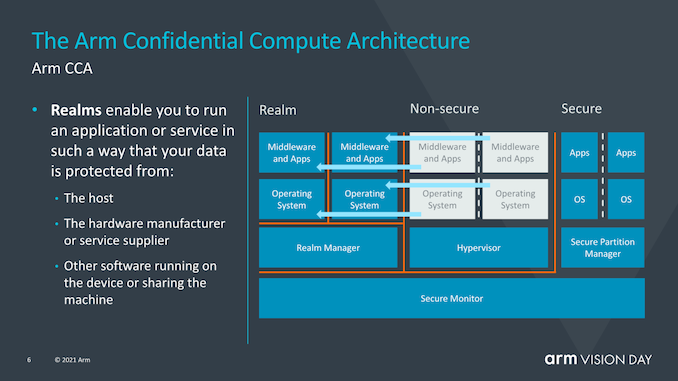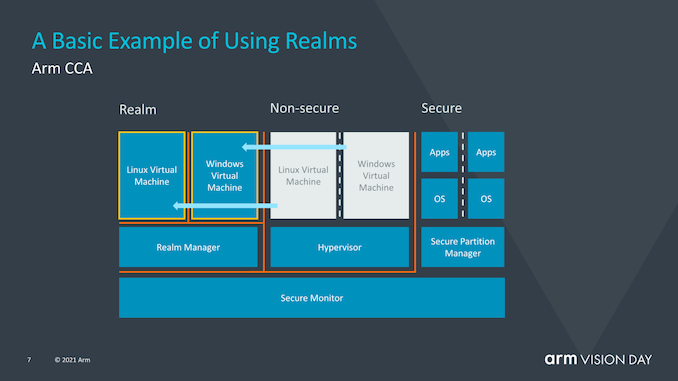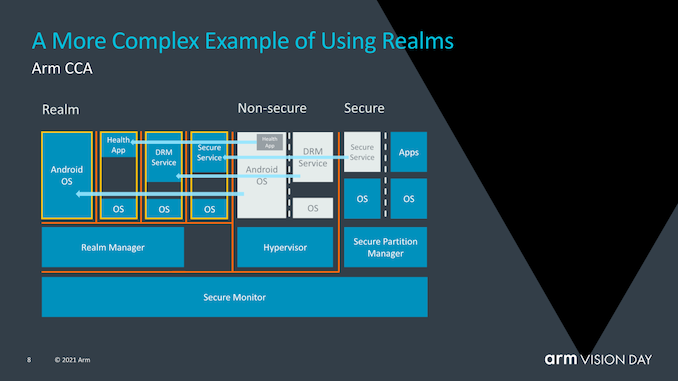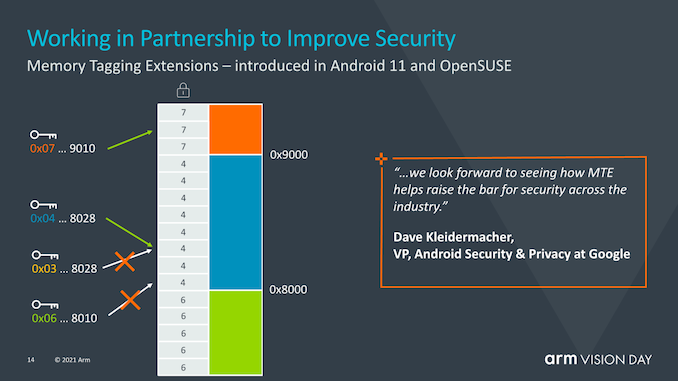Arm Announces Armv9 Architecture: SVE2, Security, and the Next Decade
by Andrei Frumusanu on March 30, 2021 2:00 PM ESTIntroducing the Confidential Compute Architecture
Over the last few years, we’ve seen security, and security breaches of hardware be at the forefront of news, with many vulnerabilities such as Spectre, Meltdown, and all of their sibling side-channel attacks showcasing that there’s a fundamental need for a re-think of how to approach security. One way Arm wants to address this overarching issue is to re-architect how secure applications work with the introduction of the Arm Confidential Compute Architecture.
Before continuing, I want to warn that today’s disclosures are merely high-level explanations of how the new CCA operates, with Arm saying more details on how exactly the new security mechanism works will be unveiled later this summer.
The goal of the CCA is to more from the current software stack situation where applications which are run on a device have to inherently trust the operating system and the hypervisor they are running on. The traditional model of security is built around the fact that the more privileged tiers of software are allowed to and are able to see into the execution of lower tiers, which can be an issue when the OS or the hypervisor is compromised in any way.
CCA introduces a new concept of dynamically creates “realms”, which can be viewed as secured containerised execution environments that are completely opaque to the OS or hypervisor. The hypervisor would still exist, but be solely responsible for scheduling and resource allocation. The realms instead, would be managed by a new entity called the “realm manager”, which is supposed to be a new piece of code roughly 1/10th the size of a hypervisor.
Applications within a realm would be able to “attest” a realm manager in order to determine that it can be trusted, which isn’t possible with say a traditional hypervisor.
Arm didn’t go into more depth of what exactly creates this separation between the realms and the non-secure world of the OS and hypervisors, but it did sound like hardware backed address spaces which cannot interact with each other.
The advantage of the usage of realms is that it vastly reduces the chain of trust of a given application running on a device, with the OS becoming largely transparent to security issues. Mission-critical applications that require supervisory controls would be able to run on any device as say opposed to today’s situation where corporate or businesses require one to use dedicated devices with authorised software stacks.
Not new to v9 but rather introduced with v8.5, MTE or memory tagging extensions are aimed to help with two of the most persistent security issues in the world’s software. Buffers overflows and use-after-free are continuing software design issues that have been part of software design for the past 50 years, and can take years for them to be identified or resolved. MTE is aimed at helping identify such issues by tagging pointers upon allocation and checking upon use.
















74 Comments
View All Comments
HardwareDufus - Friday, April 2, 2021 - link
you are a rather offensive and unpleasant person.... why do you repeatedly say things like are you stupid, that sounds stupid, are you on drugs?can you find a nicer way to express your disagreement with what others have posted?
grant3 - Wednesday, March 31, 2021 - link
TSMC is a design-agnostic foundry. They build the highest performing x86 chips available. They will (presumably) continue to build x86 as long as a customer is willing to pay to have them built.I presume you're saying Apple is the 2nd biggest threat to x86 because they are transitioning away from x86 processors in their computers. But apple is transitioning TOWARDS arm architecture. So it's completely nonsensical to say "Apple (the company) is a bigger threat than ARM (an architecture)t" when they are both integral to the same transition.
Furthermore: Apple computers have used x86 architecture for a lot fewer years than they DID use x86 architecture. Apple's transition might by a *symptom* of x86 possibly approaching end-of-life, but it sure is not a CAUSE of it. Until Apple obtains a vast majority of personal & server computing market share, which would be unprecedented, it is not itself a threat to x86 remaining a highly-used computing architecture.
Ppietra - Wednesday, March 31, 2021 - link
Threats don’t come only from companies that can reduce x86 marketshare significantly and directly. Threats also come from companies that can change people/market perception about the need of x86 processors - that is actually the first step needed before the marketshare drops significantly. Apple is one of such companies and Intel has already demonstrated that it is indeed a threat (not a symptom).Kjella - Wednesday, March 31, 2021 - link
Apple might be transitioning but software companies rarely will, they'll go from some old assembler code to a higher level language where ARM/x86 code is a compile away. While I agree that there's been a lot of false starts, the M1 is causing a lot of spring cleaning in desktop-oriented companies who's managed to ignore smartphones/tablets like for example getting Adobe to make a native version of Photoshop. If you're indifferent about ARM or x86, that's a win for ARM.back2future - Thursday, April 1, 2021 - link
Customers who decide to buy that 300 billion devices on ARM v9.x ISA that next decade are final decision about production success. If these customers (generally) stay with x86/x64 this would balance statistics in different manner and on desktops or laptops there is availability for grown, mature programs for technical drawing and design, analysis, devices support, databases access or office related support software still an advantage for to decide. Mobile devices (Android) have wider variety of (useful) apps that fulfill smaller tasks for users (like access to IoT devices, that are probably bigger share of 300 billion devices 'til 2030, been 180 billion ARM SoCs 'til 2021)?No problem having ARM device beside x64 device, because there are cheap available of either ARMv9.x or x86/x64)
melgross - Saturday, April 10, 2021 - link
To Apple, the ARM cores are just a part of their SoC, and possibly not the most important part.SarahKerrigan - Tuesday, March 30, 2021 - link
If "going nowhere" means moving core volume that makes x86 look like small fry, making serious inroads in servers and HPC, and getting the buy-in of the most profitable PC OEM (Apple), sure. What were you expecting, that "ARM succeeding" means "x86 drops to zero in eight years"? "x86 is going to be the downfall of RISC/UNIX" was something that was being said when the 486 was new, and RISC/UNIX was still a majority of server revenue into the 2000s and is still big money (billions of dollars a year today.)Shifts take time, and even if x86 does enter terminal decline - and I'm not necessarily saying it will - desktop PCs will be the last part to go.
name99 - Tuesday, March 30, 2021 - link
Uhh, ARM IS the next big thing TODAY.Last time I checked the mobile market is a lot larger than the PC market...
You're like the guy who insists "microprocessors never won! IBM is still selling mainframes and they still kick ass". It's true. mainframes still sell, and still kick ass. But they don't define the state of computing.
Intel will be around for a long time supporting the "requires x86 market"; that was never in doubt. The point is, x86 no longer defines the interesting state of computing; it's fading away to mainframe status before our eyes.
Oh sure, there'll be a few more glory years -- peak IBM was 1985 -- but the pattern is laid out.
And are you incapable of understanding the article? SVE/2 WILL be available across the industry! That's a large part of the point of creating this new v9 branding and establishing a new baseline for the ARM community.
darkich - Wednesday, March 31, 2021 - link
Exactly.29a - Wednesday, March 31, 2021 - link
"ARM was prophacized in 2013 as the next big thing, and it went nowhere"I guess 99.999999999999% of mobile devices is nowhere?